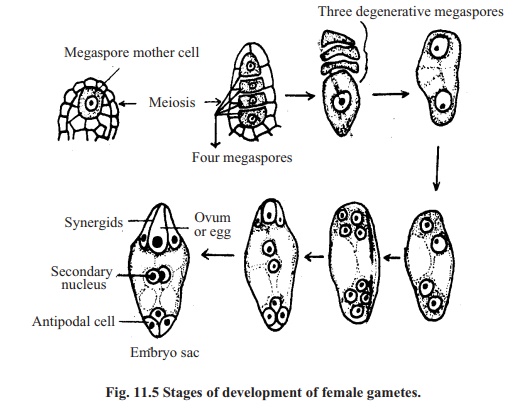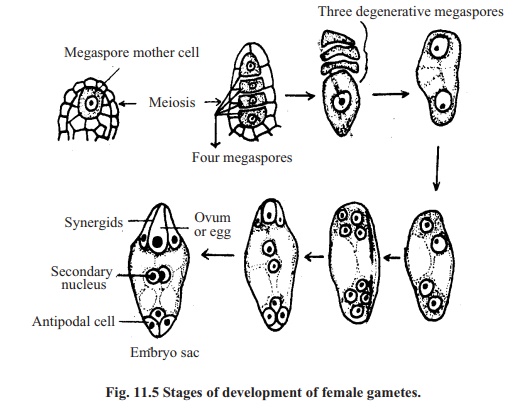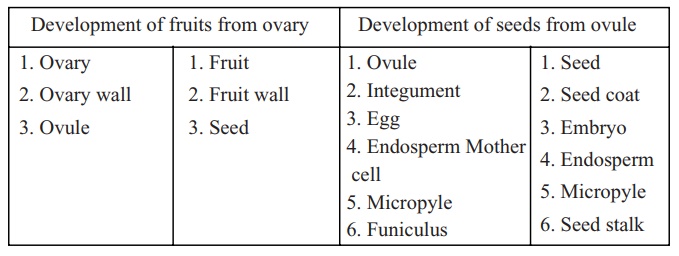Chapter: Biology: Pollination, Fertilization, And Dispersal of Fruits and seeds
Fertilization in Plant

Fertilization:
We know there are small organs named ovules in the ovary of a flower. These ovules later on develop to seeds. The seeds we see in the fruits like Mango, Jambolina (Jaam), Lichi, Jackfruit etc. all are the developed ovule. When the ovule gradually develops to seeds at the same time the ovary of the flower gradually develops to a fruit. Ovules are developed to seed as a result of fertilization. Usually without fertilization ovules cannot be developed to seeds Again fertilization also causes the ovary to form a fruit. For fertilization it is necessary to originate male and female gametes. In flowering plants union of male and female gametes is called fertilization.
Formation of male gamete:
Inside the anther there are pollen mother cells. Bymeiosis four pollen grains are produced from each pollen mother cell. Each pollen grain contains two coverings, the outer coating is called exine and the inner one is called intine. In the exine there is a pore named germ pore Nucleus of the pollen grain undergoes mitotic division and forms tube nucleus and generative nucleus. Usually pollination occurs at this bi-nucleated condition.

As a result of pollination, the pollen grains become attached to the stigma and a pollen tube is developed from the pollen grain. The tube gradually makes its way down into the ovary through the style. The tube nucleus enters the pollen tube followed by the generative nucleus. The generative nucleus undergoes mitotic division and form two male reproductive cells or male gametes or sperms. The male gametes are haploid.
Formation of female gamete:
Inside the ovary of a flower there lies the ovules. In each of these ovules one megaspore mother cell (female reproductive mother cell or egg mother cell) is produced. This cell undergoes meiotic division to give rise to four haploid megaspores. In most of the cases three out of four degenerate and only one cell survives. The nucleus of the survived large cell divides mitotically to give rise to two at first, next from these two forms four and then from four to eight nucleus. These eight nucleus remains at two poles of a sac like structure. The sac like structure is called embryo sac. One nucleus from each pole moves to the centre of the embryo sac and fuse together to form a secondary nucleus. The three nuclei remaining at the micropyler end of the embryo sac are called egg apparatus. The central one of these three is larger one and it forms the egg or ovum, and the other two besides the ovum are synergides. Ovum is the female reproductive cell or female gamete. The rest nuclei of the embryo sac are called antipodal cells. The ovum ishaploid.
Union of female and male reproductive cell: The pollen tube graduallyproceeds and moves downwards and ultimately reaches the embryo sac. When the pollen tube reaches the embryo sac the tip of the pollen tube bursts and thetwo male gametes are released. One of the male gametes. (sperm cells) unites with the egg and complete the process of fertilization. The other male gamtees unite with the secondary nucleus. This union is called triple fusion. This process is known as double fertilization
Stages of Fertilization: From the above discussion it is understood that thereare three stages in the process of fertilization, namely - 1. Development of male gametes, 2. Development of female gametes and 3. Union of male and female gametes.

Development of Embryo: Embryo develops after fertilization. A diploidzygote is developed as a result of the union of male and female gametes. It is also called a fertilized egg. The zygote remains in resting stage for sometimes (may be few hours, days or even months). After the resting period the zygote cell undergoes a transverse division to form a bi-celled pro-embryo. The pro-embryo then undergoes successive cell division at different plains to form an embryo. An embryo consists of cotyledon and an axis. The upper portion of the, axis is the plumule and the lower portion is the radicle. In a monocot seed there is only one cotyledon (e.g. coconut, paddy etc) and in a dicot seed there are two cotyledons (e.g. mango, bean, gram, pea etc.).
Development of Endosperm:
Endosperm is an essential constituent part of the seed. The food for developing embryo is preserved in it and the embryo absorbs food from the endosperm. The triploid cell originated from the union of secondary nucleus of the embryo sac and a male gametes, is the first cell of the endosperm. The triploid cell undergoes mitotic division repeatedly to give rise to a mature endosperm. The endosperm is triploid i.e. three nuclei fused together to form it.

In many plants endosperm is present in a mature seed. During germination, the embryo absorbs food from the endosperm. These types of seeds
are called endospermic seed - e.g. Paddy, Wheat, Ricinus etc. In many other plants endosperm being absorbed and stored in cotyledon and is utilised during germination. This type of seeds are called non-endosperm seed e.g. Gram seed, Pea, Mango etc.
After fertilization the ovary is developed to fruit and the ovule developed to seed. Changes in ovary and ovule after fertilization is shown in the following table:

Significance of fertilization:
As a result of fertilization the ovary of a flower develops to a fruit and ovules to seeds. Seeds maintain and increase the generation by reproduction. If there were no seed probably the plant would have perished. This may be said in other words as, if there was no fertilization the plants would have perished. Again animal world especially human being live on fruits and seeds of plants. If there was no fertilization seeds and fruits would not have grown. No animal life could exist without the food produced by plants. So the significance of ferti-lization is unlimited
Related Topics